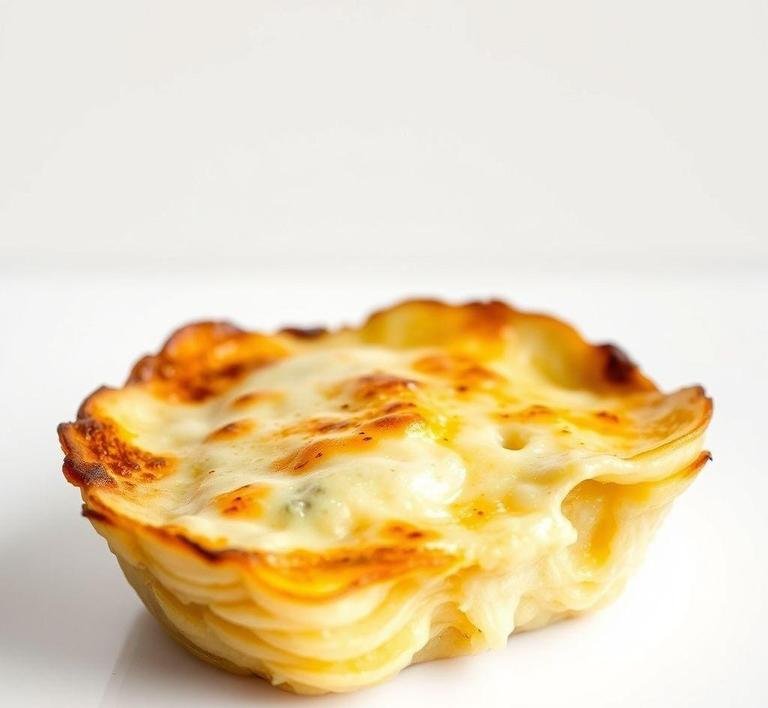I still remember the first time I made Nigella Lawson’s Potato Dauphinoise. It was a rainy Sunday afternoon, the kind that calls for something comforting, indulgent and slow-cooked. I was flipping through one of Nigella’s cookbooks (I think it was Feast, although I’ve mixed recipes from her TV shows too) and there it was – golden, bubbling, creamy layers of sliced potato cloaked in garlic-infused cream. I mean, what’s not to love?
Nigella’s Potato Dauphinoise isn’t your everyday potato dish. It’s French in origin (from the Dauphiné region) but she brings her signature sensuality and warmth to it. It’s not just about making potatoes taste good. it’s about honoring the potato. She doesn’t fuss too much which I love. No cheese, no breadcrumbs, just cream, garlic and the magic of slow baking. The result is rich but somehow not heavy, a dish that speaks to your soul in hushed tones.
Nigella Potato Dauphinoise Recipe
Ingredients Needed

The beauty of this dish is how few ingredients you actually need. but the key is in how you treat them.
- Potatoes – Waxy ones are best: think Desiree, Charlotte or Yukon Gold if you’re in the U.S. You want potatoes that hold their shape but still soak up the creamy goodness.
- Garlic – Nigella uses it generously, rubbing the dish with a clove and sometimes adding more to the cream. Don’t skimp – the garlic isn’t overpowering, it’s just right.
- Double Cream – This is where the decadence comes in. Double cream (or heavy cream in the U.S.) gives you that lush, almost custard-like texture.
- Whole Milk – Some versions blend cream and milk. I’ve found using all cream gives you a thicker, richer finish but it’s worth experimenting.
- Butter – For greasing the dish and that little extra indulgence.
- Salt & Pepper – Simple, essential and transformative.
That’s it. No cheese. I know, some people are suspicious about leaving cheese out of something that looks so gratin-y but trust the process.
Equipment Needed
I’ve made this in all sorts of setups. once in a tiny Airbnb kitchen with a single blunt knife. but here’s the ideal lineup:
- A sharp knife or a mandoline (this makes all the difference; uniform thin slices = even cooking).
- A large mixing bowl (if you’re pre-mixing the cream with garlic and seasoning).
- A baking dish (ceramic or glass is best, about 9×13 inches or a medium oval dish).
- Aluminum foil (you’ll need this to cover the dish partway through cooking).
- An oven, of course. ideally with good temperature control.
And while it’s not required, a glass of wine and some good music definitely helps with the vibe.
Instructions To Make Nigella Lawson’s Potato Dauphinoise
Here’s how I do it, following Nigella’s loose but intuitive approach:
-
Prep The Dish
First, preheat your oven to 160°C (320°F). Rub your baking dish with a halved clove of garlic. this sounds like a small step but trust me, it’s aromatic magic. Then butter the dish generously.
-
Slice The Potatoes
Peel your potatoes and slice them thin. about 3mm thick. I used to do this with a knife but after one too many uneven bakes, I invested in a mandoline. Best decision ever. Just watch your fingers!
-
Layering With Love
Begin layering the potatoes in the dish. Slightly overlapping, like scales. Between layers, season with salt and freshly ground pepper. If you’re adding garlic to the cream, mix it in now. I sometimes scatter in a tiny grating of nutmeg if I’m feeling nostalgic. my grandmother did that, even in dishes she didn’t understand.
-
Pour Over Cream
Warm your cream gently on the stove with a bit of garlic and seasoning if you like, then pour it over the potatoes until it just barely covers them. Don’t drown them – the cream will bubble up and thicken.
-
Bake Low And Slow
Cover with foil and bake for about 1 to 1.5 hours. Then uncover and bake for another 30 minutes or until golden and the top is gently crisping. I usually test with a knife. it should slide in with no resistance, like slicing through butter.
-
Rest Before Serving
Let it sit for at least 10 minutes before serving. This is crucial. It sets the layers and lets the flavors settle. Molten cream on your tongue is a dangerous game.
What I Learnt
Making this taught me that simplicity, when done right, is powerful. The first time I made it, I fretted over the lack of cheese. I even grated some Gruyère “just in case”. But I didn’t use it and I’m so glad. Nigella’s version relies on confidence. in the ingredients, in the process and in letting food speak for itself.
I also learnt the power of patience. Low heat, long bake. There’s no rushing this. And it’s oddly meditative. slicing, layering, seasoning. It reminds me that cooking doesn’t have to be flashy or complex to be deeply satisfying.
Oh and lastly? Leftovers are divine. A square of it, reheated in a pan with a fried egg on top, the next morning? That’s the kind of breakfast that makes you believe in love again.
FAQs
What Makes Nigella Lawson’s Potato Dauphinoise Different From Other Recipes?
Nigella’s version of dauphinoise stands out because she simplifies the technique without compromising on flavor. She doesn’t go overboard on the cream or cheese, which means the potatoes really shine. I love how she uses garlic and a hint of nutmeg to elevate the dish without making it overly rich. It’s comfort food, but with a touch of elegance.
Can I Make Nigella’s Potato Dauphinoise Ahead Of Time?
Absolutely! This is one of those dishes that gets even better when it’s made ahead. You can assemble it the day before and refrigerate it. Just make sure to let it come to room temperature before popping it in the oven. I’ve done this for a dinner party before, and it was a total lifesaver!
What Type Of Potatoes Work Best For Nigella’s Dauphinoise Recipe?
Nigella recommends using waxy potatoes, like Charlotte or Yukon Gold. They hold their shape better when baked and give that lovely creamy texture you want. I’ve used all sorts of potatoes before, but the waxy ones really make a difference in terms of consistency and flavor!


